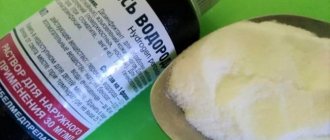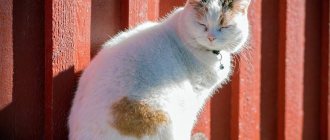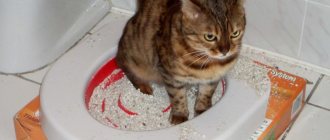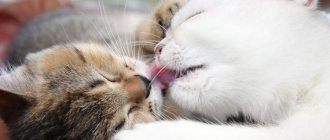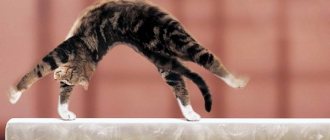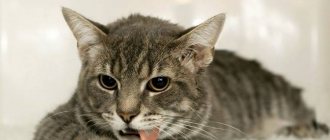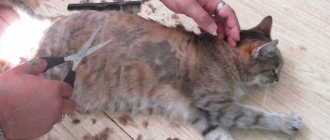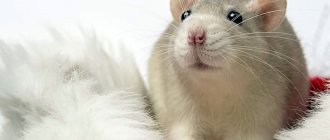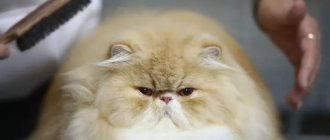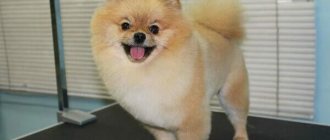A cat's fur is one of the indicators of its health and proper maintenance. The beautiful, smooth, shiny coat of a pet is the pride of the owner, especially if it participates in exhibitions.
The appearance of mats (matted dense balls of hair) indicates insufficient daily care or other problems for the pet. More often, cats of long-haired breeds (Persian, Maine Coon, Neva Masquerade, Turkish Angora, Siberian, Burmese, Norwegian Forest) suffer from this, since these animals cannot fully care for their thick and long hair. In cats of short-haired breeds, tangles can appear when sticky or adhesive substances come into contact with the fur: resin, varnish, paint, etc.
Reasons for the formation of tangles
Most cats do not develop hairballs if they are healthy and able to maintain their fur. But some of the breeds that have long fluffy “cotton-like” hair with a very thick undercoat are more prone than others to the formation of matted and compacted hair. These are Persians and Turkish Angora.
At the same time, such long-haired domestic animals as Siberians and Maine Coons suffer less and less often from tangles, since they have a long coat, and mainly the lumps form in places of very thick, wavy and curly undercoat - on the “collar” " and on the "pants".
Such wool tends to cling to neighboring hairs and become very dense, forming felt - this is a tangle. It occurs in most situations in the following cases:
- the animal is poorly looked after or not groomed at all;
- often formations appear during the molting period, when the fur begins to actively grow, and no one helps the cat to get rid of it;
- often the fact that the cat’s hair has begun to fall off indicates that the animal is sick;
- in rare cases, the animal itself refuses to lick itself, so the owners have to take care of its fur, and they wash it with their own shampoo and, when soaping, vigorously crumple the fur, resulting in dense felt;
- mats are a common occurrence in lazy and fat animals that are obese.
In most situations with health problems in animals, humans are to blame, so all owners should know exactly how to get rid of mats in a cat and how to prevent their formation in the future.
INTERESTING TO KNOW: Do-it-yourself warm felted house for a cat
Why tangles are dangerous and why remove them
The tangles prevent the animal from moving. During active actions, the cat may get caught on something and get injured. Subsequently, she may treat the furball as a sore spot, which will make it difficult for the owner to cut it off.
Of course, matted fur does not pose a threat to the life of the fluffy beauty, but mats, nevertheless, must be gotten rid of, since they can provoke additional problems:
- first of all, it is the ugly appearance of the animal;
- formed from lost hair, the hairball also captures the growing hair, tearing it out, and this is unpleasant and painful;
- cats, as a rule, want to get rid of matted hair themselves and begin to lick and bite it, sometimes this leads to serious skin irritations;
- a large amount of matted hair impedes the movement of air, the animal begins to sweat, and this is fraught with the appearance of various dermatitis;
- A favorable environment for ectoparasites is formed inside the felt ball.
If your cat has a mat that is too dense, removing it will be unpleasant and even painful. Trimming is not advisable, since the hair of long-haired cats takes a long time to grow: up to six months.
The harm of downed wool to animal health
When mats occur in cats, its natural ability to lick itself is disrupted, the coat becomes dirty and greasy, and this is an excellent breeding ground for microorganisms. Such an animal is at greater risk than others of contracting fungus, lichen, as well as fleas and lice.
Under the rough clumps that matted and compacted fur forms, diaper rash and irritation of the skin appear, and it can become inflamed. In addition, the animal experiences discomfort and pain, as the lumps pull on the skin. If there are a lot of them, the animal suffers greatly and can get sick, and its character even deteriorates.
Why do tangles form?
Long-haired cats definitely need timely care. If you do not monitor the condition of the animal's fur, very soon the pet will become covered with tangles. Most often they appear in places of bends and friction - behind the ears, armpits, on the stomach, in the groin, and in advanced cases - on the sides. Sometimes mats can appear due to improper care of the animal.
When washing, you need to gently stroke the fur, and not lather or ruffle it. The fact is that such wool is very difficult to comb, so washing should be delicate. During periods when the cat sheds old fur, the animal needs to be combed daily.
If you don't do this, you won't be able to avoid tangles. Sometimes hair may fall out excessively due to poor nutrition. Long-haired cats require a balanced diet, with a full range of vitamins and minerals. If your cat eats dry food, do not forget to supplement its diet with special vitamin complexes. If mats appear suddenly, despite careful care of the animal, the condition and hair loss may indicate an illness in the cat. At the same time, the coat often becomes greasy and dull.
In addition to the fact that tangles look terribly unaesthetic, they are also dangerous for the animal. Firstly, in the hot season, mats disrupt normal thermoregulation - the cat can simply overheat, and as a result, traces of dermatitis appear on the skin. The second reason why you need to get rid of tangles as soon as possible is that they are a breeding ground for bacteria. Not only microbes and viruses can settle inside these hairballs, but also larger representatives of insects - fleas and ticks. In addition, tangles really bother the cat herself, bringing her a lot of inconvenience. Often, animals try to get rid of hairballs on their own by tearing them out, leaving injuries on the skin.
All this suggests that tangles should not be allowed to appear on the animal’s fur. If this does happen, you need to get rid of this unpleasant problem as soon as possible.
Removal of small problematic formations
In most cases, tangles rarely occur in domestic well-groomed cats, mainly during the molting period, and they are based mainly on the neck and in the area of “whiskers” and “collar”, that is, where the animal itself cannot properly lick its long, thick hair.
If a cat has small tangles, and they are more like knots, they can be carefully and carefully, without injuring the animal, disassembled by hand. In this case, it is better to act together, without unnerving the purr. Then it is advisable to comb the fur coat completely to remove any remaining “dead” hair.
This procedure is unpleasant for cats, so you need to pet her, talk in a quiet voice and give her a treat so that she does not associate the comb and scissors with unpleasant moments.
If the tangle is dense, pulling the skin underneath or located close to it, there is only one choice - cut it. Ideally, you should use scissors with round edges, as you would for cutting a baby's nails.
In general, the best way to comb a cat’s tangles is to prevent their formation.
Basic information about tangles
A mat is a dense lump formed from old felted wool. Young, healthy animals spend enough time on hygiene, licking themselves regularly and for a long time. In this way, they remove dead, fallen hairs, so that tangles do not appear.
Elderly and sick cats usually do not have enough strength to properly care for their fur coat.
For this reason, their fur intertwines, gets tangled and forms dense clumps. But sometimes even young individuals fail to prevent the formation of tangles. What are the reasons for such negative changes?
How to cut out a hairball correctly
When the need to cut off lumps arises, the question arises; how to remove small tangles from a domestic cat without accidentally injuring it. Firstly, the animal must be fixed, secondly, use sharp scissors with blunt edges, and thirdly, cut along the formation, and then carefully, step by step, cut it from the fur.
Sometimes it is recommended to use an anti-matt spray for cats, reviews of which are very favorable and positive. It is especially necessary for animals with “cotton” hair, like Persians and Angoras. With its help, you can quickly and painlessly remove tangles.
Preventing the appearance of mats in cats
It is easier to prevent tangles from appearing than to untangle and comb them out later. To do this, it is important to follow the following rules.
Health monitoring
It is recommended to regularly examine the cat at home, for example while brushing or playing, and to have a medical examination with a veterinarian 1–2 times a year. At the first signs of illness or the presence of alarming symptoms, the animal should be taken to the veterinarian as soon as possible.
Balanced diet
Proper nutrition, taking into account the daily need for nutrients, vitamins and minerals, taking, if necessary and only on the recommendation of a doctor, complex vitamin-mineral preparations, fatty acid complexes, and having clean water available at all times are some of the main conditions that have a beneficial effect on the beauty of the coat. pet.
Careful proper care
It includes combing and periodic washing using special shampoos selected taking into account the type of animal's coat, as well as additional cosmetics to facilitate combing. In addition, it is important to prevent the air in the room where the pet lives from drying out.
For daily combing of fluffy cats, you will need combs with sparse, non-sharp teeth and special brushes. It is better to carry out the procedure in several stages so as not to cause fatigue and irritation to the animal. When combing, special attention is paid to the armpits, belly, tail, and areas behind the ears. It is necessary to accustom a cat to such manipulations from an early age. In addition, daily brushing helps not only maintain the aesthetic appearance of the coat, but also strengthens the emotional connection between the owner and the cat, allowing you to show your pet your love and care.
Grooming the cat
During the period of active molting or after an illness, mats in a fluffy cat can cover almost its entire body. This often happens in cats that have free range or are taken to the countryside for the summer. You can’t leave the fur like that, as dust, dirt, insects and plant particles will get into the formations, causing the animal to suffer greatly.
INTERESTING TO KNOW: Proper care of a Persian cat
In the heat, under such felt knots, the skin will swell and become inflamed. Therefore, if a cat’s fur is all matted, and the cat mat remover does not work, the only thing left to do is to completely cut off the matted area of fur.
Sometimes, when almost the entire fur coat has fallen off, after removing the mats, the animal is clipper-haired, leaving only the head, tail, and sometimes the “collar” fluffy. Then the fur will grow evenly, it will be easy to care for, and the animal will quickly regain its aesthetic appearance.
If your animal is aggressive or you don't know how to cut it, contact your veterinarian or pet grooming salon for help. There, the injured cat will quickly be restored to perfect condition.
Removal methods
Tangles are removed from wool in the following ways:
- If the lumps are small, you can comb them out. The pet should be placed on its side and stroked. This is necessary so that he calms down and does not break out. First, comb the sides and back, neck and chest, forelimbs, tail. It is more difficult to get rid of tangles on the stomach and hind legs. Most likely the animal will bite.
- Large clumps are recommended to be cut lengthwise and then combed.
- If there are a lot of tangles, it is completely impossible to comb them out, then the tangled hair will have to be cut to the ground. You need to be very careful: a cat’s skin is thin and can be easily damaged. Clumps can be removed with scissors, people clippers or hair clippers. The receding hairline will heal after a few months.
- At the pet store you can purchase a special device called a tangle cutter. This is a comb with blunt ends, blades between the teeth.
- You can take your cat to a veterinarian or pet groomer. There your pet will be trimmed at an affordable cost.
- To deal with long unnecessary hair, there is a special comb - a furminator. Not only will it help get rid of clumps, but it will also be an indispensable tool for daily combing.
Preventing problems with your cat's coat
Preventive measures for any fluffy long-haired cats, in particular Maine Coons, Siberians, Angoras and Persians, include the following simple rules:
- Brush the animal at least once a week (Persians are scratched more often, sometimes every day).
- To untangle the hair knot, use a special spray.
- When combing your cat's coat, use a comb with round toothed ends so as not to injure the cat.
- When shedding, be sure to remove loose hair using a slicker. At other times, this tool should not be used.
- In extreme heat at the dacha or at home, a very “shaggy” cat should be trimmed. This will not only prevent tangles, but also protect it from overheating and heat stroke.
- Sometimes, to stop the formation of mats, you need to change the cat's food or add a little more fats and vitamins.
A good owner monitors the health of his pet and its appearance. Small fur seals need to be eliminated immediately, then there will be no need for labor-intensive removal of tangles. Simple brushing takes no more than five minutes a day, brings a lot of pleasure to the animal when done correctly and protects it from painful formations in its luxurious fluffy fur.
What are mats?
The fur of cats, especially long-haired breeds, requires careful care. With a lack of hygiene, poor nutrition and other mistakes when keeping pets, their fur begins to deteriorate. This affects not only appearance, but also health.
Older pets cannot provide themselves with the same careful care as younger pets. The wool begins to get tangled, matted, and tangles form. However, young age is not a guarantee that lumps will not appear.
Indications for removing mats
Clumps of matted fur should be removed as soon as possible. Tangles are not only unsightly, but also dangerous. These formations do not pose a threat to the cat’s life, but there are direct indications for their elimination. And this should under no circumstances be ignored.
Discomfort for the animal
The tangles are quite dense in structure. Their appearance causes a lot of inconvenience to the cat.
During play, the pet may get caught in a furball on some object and pull it hard to free itself from the obstacle. As a result, the cat will be injured, and the mat itself and touching it will be associated with pain and discomfort. This will make it difficult for the owner or veterinarian to remove the lump.
Mats cause pain and discomfort to the cat
Skin diseases
If there are a large number of mats, the skin underneath them begins to swell. This is a direct road to the development of skin diseases.
Increased dryness provokes the appearance of dandruff. Excessive moisture causes inflammation and ulcers to form on the skin, through which secondary infection can occur. Sometimes this leads to infection entering the body.
Therefore, at the first signs of the formation of tangles, you need to get rid of them, and then prescribe treatment to the animal.

